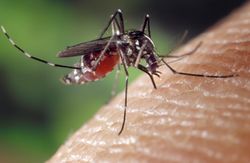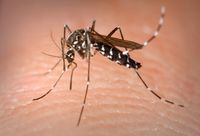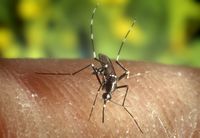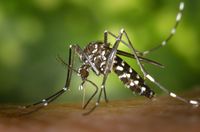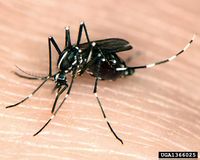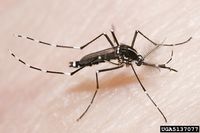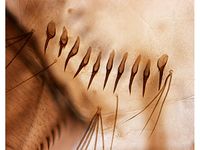Difference between revisions of "Aedes albopictus"
| Line 2: | Line 2: | ||
{{LiteratureDB|{{PAGENAME}}|browse,benefialsN}} | {{LiteratureDB|{{PAGENAME}}|browse,benefialsN}} | ||
[[File:Aedes albopictus on human skin.jpg|250px|thumb|''Aedes albopictus'' feeding on a human host<br/>Source: [http://commons.wikimedia.org/wiki/File:Aedes_albopictus_on_human_skin.jpg Wikimedia Commons]]] | [[File:Aedes albopictus on human skin.jpg|250px|thumb|''Aedes albopictus'' feeding on a human host<br/>Source: [http://commons.wikimedia.org/wiki/File:Aedes_albopictus_on_human_skin.jpg Wikimedia Commons]]] | ||
| − | <font color="#800000">'''''Aedes albopictus'''''</font> (Skuse) - Asian tiger mosquito<br/> | + | <font color="#800000">'''''Aedes albopictus'''''</font> (Skuse) - (Asian tiger mosquito)<br/> |
| − | is an aggressive, human-biting mosquito, closely associated with the human environment where it usually breeds in containers. It is native | + | is an aggressive, human-biting mosquito, closely associated with the human environment where it usually breeds in containers. It is native to Asia and is found since 1986 in North America. South America has been invaded around the same time and since 1987 it has been also reported from Europe. Since it can lay diapausing eggs it survives even in colder regions. |
| − | '' | + | ''Ae. albopictus'' is a vector of dengue fever, yellow fever, various types of encephalitis, dog heartworm (''Dirofilaria immitis'') and other diseases. Vector control is often the only or the most appropriate method to combat these diseases. |
For details see the respective page in [[wikipedia:Aedes albopictus|Wikipedia]]. | For details see the respective page in [[wikipedia:Aedes albopictus|Wikipedia]]. | ||
Revision as of 11:27, 28 November 2013
Taxonomic position
|
|---|
no parent categories |
| Literature database |
|---|
| 1812 articles sorted by: |
| • year (recent ones first) |
| • research topics |
| • countries/regions |
| • list of natural enemies |
Aedes albopictus (Skuse) - (Asian tiger mosquito)
is an aggressive, human-biting mosquito, closely associated with the human environment where it usually breeds in containers. It is native to Asia and is found since 1986 in North America. South America has been invaded around the same time and since 1987 it has been also reported from Europe. Since it can lay diapausing eggs it survives even in colder regions.
Ae. albopictus is a vector of dengue fever, yellow fever, various types of encephalitis, dog heartworm (Dirofilaria immitis) and other diseases. Vector control is often the only or the most appropriate method to combat these diseases.
For details see the respective page in Wikipedia.
Synonyms:
Stegomyia albopictus
The literature database currently contains 1812 publications for Aedes albopictus. (See box above/on left.)
- Other images of Aedes albopictus (Wikimedia Commons, PaDIL and IPM Images - click to enlarge)
